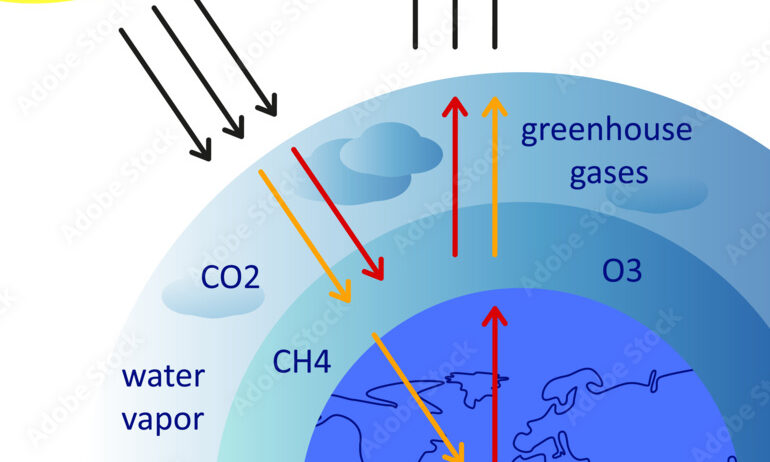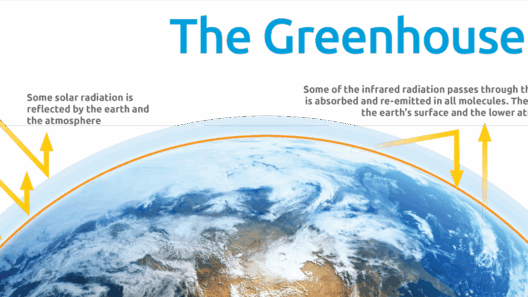The greenhouse effect is a pivotal natural phenomenon that significantly influences Earth’s climate. By understanding this concept, we can appreciate not only its scientific intricacies but also the broader implications it has on our environment. At its core, the greenhouse effect describes how certain gases trap heat in the atmosphere, creating a warming blanket that regulates temperature. This dynamic interplay between incoming solar radiation and outgoing thermal energy is critical for sustaining life on our planet.
Intriguingly, the greenhouse effect combines an elemental elegance with scientific robustness. The Earth’s atmosphere acts like a colossal shield, selectively allowing sunlight in while retaining some of that cherished warmth. While one might envision a simple blanket, this process involves complex interactions among various gases, leading to profound consequences for the climate system.
Understanding the role of greenhouse gases begins with recognizing their categorization. Chiefly, there are a handful of gases that contribute prominently to the greenhouse effect: carbon dioxide (CO2), methane (CH4), nitrous oxide (N2O), and fluorinated gases. Each possesses unique traits and varying capacities to trap heat—a concept referred to as “global warming potential.”
Carbon dioxide, for instance, is released through natural processes like respiration, volcanic eruptions, and the decomposition of organic matter. However, anthropogenic activities, primarily the combustion of fossil fuels and deforestation, have exponentially increased CO2 concentrations in the atmosphere. This surge in carbon dioxide traps additional heat, leading to a gradual rise in global temperatures.
Methane, on the other hand, is a far more potent greenhouse gas, with a global warming potential more than twenty times that of carbon dioxide over a 100-year period. Methane emissions primarily stem from agricultural practices, landfills, and the production and transport of coal, oil, and natural gas. Its efficacy in heat retention, though potent, is relatively short-lived in the atmosphere, being broken down over a span of around a decade.
In contrast, nitrous oxide arises largely from agricultural and industrial activities, particularly the use of synthetic fertilizers. Despite being present in much lower concentrations than CO2, its potency in trapping heat is about 298 times greater than that of carbon dioxide over a century. Additionally, synthetic fluorinated gases, though lesser-known, are synthetic compounds that have become increasingly significant in discussions regarding global warming due to their extraordinarily high global warming potentials and long atmospheric lifetimes.
The balance of these gases is crucial. In moderation, they create a stable environment conducive to life, maintaining an average global temperature of approximately 59°F (15°C). Without the greenhouse effect, Earth would be a frigid, inhospitable planet with surface temperatures far below that level. However, the excessive accumulation of these gases, a direct result of modern industrialization, has ushered in an era of dramatic climate change.
As we delve deeper into the implications of the greenhouse effect, it’s imperative to consider its aesthetic appeal and connectivity to the natural world. Our planet, adorned with vibrant ecosystems, relies on this delicate equilibrium. Forests flourish, oceans teem with life, and seasonal shifts occur rhythmically. Yet, as temperatures rise, these natural rhythms are thrown into disarray. Ecosystems face unprecedented challenges, from coral bleaching events in marine environments to the catastrophic loss of biodiversity on land.
Charming as Earth’s natural landscapes may be, they are vulnerable to the cascading repercussions spurred by climate change. The alteration of habitats leads to climatic refugees—species forced to migrate or face extinction. Imagine a world painted in muted colors, where the vibrant hues of lush vegetation are replaced by the starkness of barren landscapes. Such is the disconcerting potential of unmitigated climate change driven by compounded greenhouse gas emissions.
Moreover, the impact of climate change extends beyond nature. Human societies are intrinsically linked to this delicate balance. Weather patterns, food security, and water resources hinge on stable climates. From raging wildfires to catastrophic storms, the consequences of climate instability echo across nations. The interconnectedness of ecosystems and human livelihoods is a poignant reminder of the importance of preserving our collective future.
Mitigation strategies to combat the adverse effects of greenhouse gases are gaining momentum globally. From transitioning to renewable energy sources—such as solar and wind—to fostering sustainable agricultural practices, there is a growing awareness of our responsibility to safeguard the environment. Technologies aimed at capturing carbon emissions and facilitating reforestation efforts likewise hold promise for reducing atmospheric concentrations of greenhouse gases.
Ultimately, the understanding of the greenhouse effect reveals a duality: a natural mechanism that sustains life, marred by human activities that threaten its equilibrium. The aesthetic beauty of our planet is mirrored by its fragility. As stewards of this Earth, we are called to reflect upon our actions, consider their impacts, and strive toward fostering a sustainable future. The delicate dance of greenhouse gases, if managed wisely, can continue to support our thriving world—one that resonates with vibrant life and boundless wonder.






